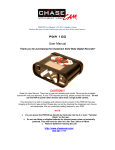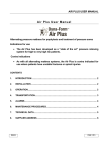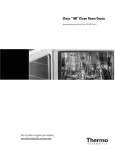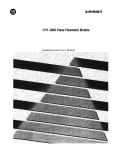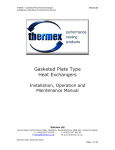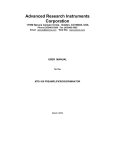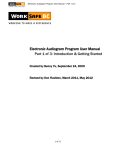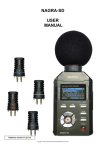Download Sanimixer 3000
Transcript
Sanimixer 3000 Installation and operation manual (including welding guideline) This user manual shall be read carefully before unpacking Sanimixer 3000®! Customer Order No: Roplan Order No: Sign: Head office: Roplan AB Skyttbrinksv. 20 SE-147 39 Tumba Sweden tel. +46-8-449 99 00 fax +46-8-449 99 90 www.Sanimixer 3000.com info@Sanimixer 3000.com Revision: 1 Date: 15th of April 2005 Sign.: Mikael Blomkvist TC SiC Sanimixer 3000® Table of Contents 1 Safety Information 2 General description of the Sanimixer 3000® 3 Handling 4 Installation and mounting 5. Technical data 6. Operation 7 Maintenance and service 8 Troubleshooting Roplan AB reserves the right to alter instructions and/or specifications without prior notice. NOTE! For bespoke designs to customer specifications, the supplied Sanimixer 3000® can differ from the descriptions within this user manual. Sanimixer 3000® EC Declaration of conformity The designating company: Roplan AB Skyttbrinksvägen 20 SE-147 39 Tumba Sweden Tel: +46-8-449 99 00 Fax: +46-8-449 99 90 mail: [email protected] www.roplan.com We hereby declare that the following machinery conforms to the provision of the directive 94/9/EC group II category 2 & 3 G when operated as per this installation and operation manual. The machinery has been designed and manufactured in accordance with the transposed harmonised standards; European and national as listed; Machine description: Sanimixer 3000® - Complete unit Type of protection: EN 13463-1:2001 `c´ `k´ Safety zones applicable: Zone 1 & 2 Special conditions: To ensure conformance with the 94/9/EC, safety instructions include specification of continuous lubrication and cooling of the Sanimixer 3000®. Maximum surface temperature: The maximum surface temperature of the Sanimixer 3000® is very much depending upon the temperature of the media processed. For further information refer to the `Operation´ section of the installation and operation manual for the Sanimixer 3000®. Installation/Operation: Installation and operation shall be performed as per this installation and operation manual for the Sanimixer 3000®. Other applicable directives: Electrical Equipment Low Voltage 73/23/EEC Electrical compatibility 89/336/EEC Machinery Safety Directive 98/37/EC Other applicable standards: EN 13463-1:2001 pr EN 13463-5 pr EN 13463-8 ISO 9001:2000 Signed: Tumba 2004-11-17 Henrik Nedlich Basic technology manager Roplan Development Center AB Sanimixer 3000® 1 Safety Information 1.1 Introduction Read the safety information chapter very carefully as it concerns your own and others safety as well as the safe function of the Sanimixer 3000®. This introduction describes how the safety information is presented in this manual and it gives general information about which safety precautions to take when you work with the Sanimixer 3000®. Always read the user manual before installing or using the Sanimixer 3000®! Special instructions for use in ATEX complying environments is included in section 6, `Operation´. 1.2 Important information Unsafe practices and other important information are emphasized in this manual by means of special signs. WARNING! Indicates that there is a great risk of personal injury as well as serious damage to the Sanimixer 3000® if the warning text is ignored. CAUTION! Indicates that minor personal injury as well as damage to the Sanimixer 3000® or major operating faults can occur if the caution text is ignored. NOTE! Draws attention to important information, which facilitates the reading of the instructions. 1.3 Signs Following warning signs are used within the user manual to further emphasize important information. General warning Dangerous electrical voltage Corrosive agents Strong magnetic fields No cardiac pacemakers allowed Sanimixer 3000® 1.4 General statement Undertaking any work envisaged by this manual may either directly or indirectly create risks to the safety and health of the person undertaking the work or the Sanimixer 3000® and/or its components whilst the work is being undertaken. It is the responsibility of the user to ensure that appropriate controls and precautions are identified and applied in relation to the work envisaged by this document in accordance with relevant statutory, legal and industry requirements to protect the health and safety of the persons undertaking the work. Neither this document, nor its use, in any way absolves the user from their responsibility to ensure that the controls and precautions referred to in this chapter are implemented. If, whilst undertaking any work envisaged by this document, you become aware of any Roplan product design related feature which could create risk to a person undertaking work or to the Sanimixer 3000® and/or its components please contact Roplan immediately. 1.5 Safety precautions Find below all warnings in this installation and operation manual summarised. Pay special attention to the instructions to ensure severe personal injury or damage to the Sanimixer 3000® are avoided. 1.5.1 Installation • • • Always observe the technical data (refer to section 5 `Sanimixer 3000® Main Parts´). Never start in the wrong direction of rotation. Never put your fingers inside the vessel or anywhere close to rotating shaft. • The Sanimixer 3000® must be electrically connected by authorised personnel. Sanimixer 3000® 1.5.2 Operation • • • Always observe the technical data (refer to section 5 `Sanimixer 3000® Main Parts´). Never touch the Sanimixer 3000® when processing hot medias. Never step on the Sanimixer 3000®. • • Only handle hazardous media as per their supplier instructions. Applicable health and safety regulations with regards to processed media must be considered. 1.5.3 Maintenance • • Always observe the technical data (refer to section 5 `Sanimixer 3000® Main Parts´). The Sanimixer 3000® must never be serviced when hot. • The Sanimixer 3000® must be electrically disconnected when being serviced. Sanimixer 3000® 2 General description of the Sanimixer 3000® The Sanimixer 3000® is a magnetically driven highly aseptic mixer for pharmaceutical, food and other relevant applications where cleaniness is a requirement. The Sanimixer 3000® may be supplied as separate components or a complete unit (see picture). The picture below specifies the different components of the Sanimixer 3000®. Control box Impeller Bearing unit Weld plate Magnetic rotor hidden under weldplate Drive unit and gearbox ® The Sanimixer 3000 has a mixing capacity for vessels with volumes ranging from 300 to 3000 litres and for other applications such as stirring up to 6000 litres. The Sanimixer 3000® is available with a wide range of different options providing flexibility for different applications. The impeller `open type´ is used within applications where the requirement for low shear forces and high CIP and/or SIP performance are not critical. For more information on the different components of the Sanimixer 3000®, refer to section 5 `Sanimixer 3000® Main Parts´. Sanimixer 3000® 3 Handling Upon receipt always: • Check the delivery note against the goods received. • If drive unit is included, check that the drive instructions are available. • Inspect the packaging for signs of damage in transit. • Carefully remove the packaging. • Inspect the Sanimixer 3000® for any visible signs of damage. • Clean away the packaging from cavities. • Report any damage to the carrier. Weights of the different components of the Sanimixer 3000® is specified within section 5 `Sanimixer 3000® Main Parts´. If the Sanimixer 3000® is not to be installed immediately, the Sanimixer 3000® should be repacked in the original package and stored in a suitable storage after receipt and inspection. The following should be considered with regards to storage: • The storage shall be a clean, dry location free from vibration. If a moist or dusty atmosphere is used for storage, further protect the Sanimixer 3000® with a suitable cover. WARNING! The Sanimixer 3000® impeller and magnetic rotor includes strong magnets thus personnel equipped with pacemaker shall not handle these components. NOTE! The Sanimixer 3000® impeller and magnetic rotor includes strong magnets thus magnetic cards, e.g. credit cards, can be permanently damaged if being close to the components specified. CAUTION! Ensure that lifting equipment chosen is suitable and properly used. Sanimixer 3000® 4 Installation and mounting 4.1 Welding guide 4.1.1 About the welding guide The welding procedure described in this guide has been used for welding the weld plates into Steridose vessels. The guidelines refer only to the technical aspects of welding operations. Do note that welding currents, time frames etc are approximate and may vary in practice. NOTE! Ensure that the vessel is compliant with relevant standards for pressure vessels. The most common fault occurring for the weld plate, is deformation introduced when welding the weld plate into the dished end of the vessel. To minimise the risk of faults occurring after delivery from Roplan AB, it is therefore essential that the welding guide is thoroughly studied and that only properly trained, experienced and qualified personnel are employed in the welding operations. 4.1.2 General A weld plate may be welded into the lower dished end, before or after the dished end is welded to the jacket. For purely practical reasons, it is usually easier to weld the weld plate to the dished end before the jacket and the dished end are welded together. All other welding on the lower dished end must however be completed before making a hole for the weld plate. 4.1.3 Positioning and orientation of Weld Plate 4.1.3.1 Information for design and orientation of Weld Plate • • • NOTE! The normal position for the drive unit is 270° as shown in figure. The lock nuts on the weld plate shall then be positioned in direction 0° - 180° as shown in figure. If the drive unit will have another direction, the weld plate has to be positioned in accordance to that direction. For best performance, the weld plate has to be mounted as close as possible to the centre of the tank. Sanimixer 3000® 4.1.3.2 Distance between welds Ensure the distance in between the weld-in components are in accordance to relevant pressure vessel regulation. NOTE! 4.1.3.3 min, distance For best performance, the weld plate has to be mounted as close as possible to the centre of the tank. Distance from outer edge Ensure that the weld plate is positioned in accordance to relevant pressure vessel regulation. Normally, these specify that the weld plate shall be positioned in such way that no part of it’s weld is outside the large radius R2 (refer to figure below). 4.1.4 Optimum alignment of Sanimixer 3000 impeller axis The weld plate should be positioned in the lower dished end allowing the impeller axis to be aligned as close as possible to a diagonal through the centre of the vessel. This ensures maximum mixing effect and minimum risk of creating a vortex and subsequently the intake of air into the product. For best mixing result the dimension L shall be equal at the top and bottom. NOTE! For best performance, the weld plate has to be mounted as close as possible to the centre of the tank. L L L Bottom dished end end L Bottom conical Sanimixer 3000® 4.1.5 Making and Preparation of Hole in the Dished End 1. Mark the hole diameter on the outside of the lower dished end. Refer to table for proper hole diameter. 2. Cut a hole with appropriate equipment along the mark on the dished end. 3. Prepare a suitable weld gap between the dished end and the weld plate by grinding the edge of the cut hole. This weld groove should be kept as small as possible. The weld plate can be used as a template. 4. Prepare the hole for welding by grinding a 45° angle, sloping outwards (see figure). A straight edge about 1 to 2 mm should be left towards the inside of the vessel. 4.1.6 Weld plate Sanimixer 3000 Tack welding the weld plate (TIG) 1. The weld plate shall not have the bearing unit or any screws fitted during welding operation. 2. Position the weld plate in the cut hole of the dished end, ensuring it is properly orientated in the correct position (refer to 4.1.3.1). 3. Tack weld the weld plate at two points on the inside, (1 and 2 in the figure) using a correct filler (filler material depends upon the material in the dished end and weld plate). 4. Check how the weld plate is fitted. It shall be flush with the inside of the lower dished end. 5. Tack weld the weld plate at two more points from the inside (3 and 4 in the figure). 6. Turn over the dished end and place it on a flat bench. Seal it between the bench and dished end with the aid of tape or similar. Fill the dished end with argon gas. It will normally take about 3 or 4 minutes to replace the air with the inert argon gas. 7. Tack weld the weld plate from the outside. The sequence 5-16 as shown in the figure shall be followed (diagonal welding). NOTE! Use as little heat as possible and weld in small steps with low current. Allow the dished end and the weld plate to cool slowly on completion of each step of welding. No cooling medium other than air shall be used. Diameter Ø149 Hole diameter Diameter of the weld plate +1 mm (maximum) for the weld joint. Sanimixer 3000® 4.1.7 Final Welding The final welding shall start closest to the centre of the dished end. The filler material should be the same as used previously. Weld continuously from point 1 to point 2 alternating in between path A and B (refer to figure) until the weld groove is filled. The dished end should be inverted again and welded from the inside to even out the weld joint. NOTE! 4.1.8 1. 2. 3. 4. 5. 6. Use as little heat as possible and weld in small steps with low current. Allow the dished end and the weld plate to cool slowly on completion of each step of welding. No cooling medium other than air shall be used. After Welding Allow the dished end and the weld plate to cool slowly on completion of welding. No cooling medium other than air shall be used. Grind and polish the inside and outside of the weld to the required finish. Re-assemble the screws for the bayonet connection. Tighten and secure the screws to the weld plate with appropriate thread locking, e.g. Loctite 243. Fit the bearing unit to the weld plate. Tighten the bearing Weld plate / Bearing unit Max unit with a torque as per the table. torque Fit the impeller on the bearing unit and turn a few Sanimixer 3000 20 Nm revolutions by hand to ensure adequate clearance to the weld plate and the vessel. If interference is present, necessary corrections have to be performed. Fit the drive unit to the vessel as per instructions (refer to section 4.4) to ensure adequate clearance to the weld plate and the vessel. If interference is present, necessary corrections have to be performed. Sanimixer 3000® 4.2 Mounting of bearing unit and impeller The bearing materials used are either Tungsten Carbide (TC) or Silicon Carbide (SiC), which are very hard but brittle materials. It is therefore important that the bearing is protected from physical damage. It is also of the utmost importance that the bearing surfaces are kept free from particles to avoid damage or disturbances of the bearing function during operation. WARNING! Ensure the impeller and vessel are clean. Do also ensure the vessel has been cooled, depressurised and ventilated from any possible gases, and that processed media are not, and cannot be, allowed to enter the vessel during maintenance work. CAUTION! Before the bearing unit and the impeller are to be mounted, the vessel, pipes and other installed parts must be thoroughly cleaned from dirt and in particular loose metal particles (can occur in new vessels). Wetted Sanimixer 3000® components can otherwise be permanently damaged. 4.2.1 Mounting of bearing unit Carefully fit the bearing unit together with the PTFE washer to the weld plate and tighten to a proper torque listed below. Make sure that the PTFE washer has not been incorrectly trapped during this operation. Bearing unit size Sanimixer 3000 NOTE! 4.2.2 Torque 20 Nm Replace the PTFE washer each time the bearing is dismounted. Mounting of impeller Carefully position the impeller onto the bearing unit and spin by hand to ensure that the impeller runs freely. WARNING! The Sanimixer 3000® impeller includes strong magnets thus personnel equipped with pacemaker shall not handle these components. CAUTION! Due to the strong magnetic forces generated by the magnets, the impeller must be mounted before the drive unit to avoid any damage on the bearings. NOTE! Extreme care should be taken to prevent damages to the bearings when mounting the impeller. NOTE! The Sanimixer 3000® impeller and magnetic rotor includes strong magnets thus magnetic cards, e.g. credit cards, can be permanently damaged if being close to the components specified. Sanimixer 3000® 4.3 Bearing and impeller mount tool (optional) To change impeller and male bearing in applications when it is difficult to enter the tank, a special `Bearing and impeller mount tool´ can be used. It consists of the following parts: • • • • Handle Bearing mount tool Impeller mount tool “Hair pin” To allow easy mounting of the male bearing it is recommended to apply a small amount of suitable grease onto the PTFE washer. This prevents the PTFE washer from loosening from the bearing unit during mounting. The `Bearing and impeller mount tool´ is to be ordered separately. Handle “Hair pin” Bearing mount tool Impeller mount tool Sanimixer 3000® 4.4 Mounting and dismounting of drive unit The drive unit consist of a motor, gearbox, flange and rotor. 4.4.1 Mounting of drive unit Ensure the magnetic rotor is not damaged and properly aligned preventing physical contact with the weld plate upon installation and operation. Be certain that you can handle the weight of the drive unit. Take a firm grip of the gearbox to balance the weight of the drive unit and to minimise the risk of damage caused by crushing when dismounting. Use appropriate lifting device. 1. Lift the drive unit up and let the welding plate’s screws pass through the slots in the drive plate. 2. Turn the drive unit counter clockwise into position. 3. Lock the drive unit in position by tightening the locking nuts. CAUTION! Due to the strong magnetic forces generated by the magnets, the impeller must be mounted before the drive unit to avoid any damage on the bearings. WARNING! The Sanimixer 3000® magnetic rotor includes strong magnets thus personnel equipped with pacemaker shall not handle these components. NOTE! The Sanimixer 3000® impeller and magnetic rotor includes strong magnets thus magnetic cards, e.g. credit cards, can be permanently damaged if being close to the components specified. WARNING! Ensure the power supply is disconnected and not possible to accidentally be connected. CAUTION! The drive unit can be heavy, refer to section 5 `Sanimixer 3000® Main Parts´. Sanimixer 3000® 4.4.2 Dismounting of drive unit Dismount the drive unit by following the mounting instructions in reverse order. Be certain that you can handle the weight of the drive unit. Take a firm grip of the gearbox to balance the weight of the drive unit and to minimise the risk of damage caused by crushing when dismounting. Use appropriate lifting device. WARNING! The Sanimixer 3000® magnetic rotor includes strong magnets thus personnel equipped with pacemaker shall not handle these components. CAUTION! Due to the strong magnetic forces generated by the magnets, the drive unit must be dismounted before the impeller to avoid any damage on the bearings. NOTE! The Sanimixer 3000® impeller and magnetic rotor includes strong magnets thus magnetic cards, e.g. credit cards, can be permanently damaged if being close to the components specified. WARNING! Ensure the power supply is disconnected and not possible to accidentally be connected. CAUTION! The drive unit can be heavy, refer to section 5 `Sanimixer 3000® Main Parts´. 4.5 Power Installation The motor applied to the Sanimixer 3000® is a AC driven type. • • Any electrical connections shall be carried out by an authorised electrician in accordance with applicable regulations, standards and directives. If a control box is used, the drive unit is connected to the control box, which in turn is connected to the external power supply. An electrical drawing/wiring diagram is supplied with the motor (drive unit) and control box upon delivery when applicable. Technical information for the motor (drive unit) and the control box is found within the documentation enclosed with the equipment. Sanimixer 3000® 4.6 Installation check and calibration 4.6.1 Verify the direction of rotation for the impeller 1. Make sure that there is a film of fluid between impeller and bearing unit by filling the vessel with water having the impeller fully immersed. 2. Set the speed potentiometer/regulator to zero. 3. The Sanimixer 3000® starts at low speed. 4. Visually check the direction of rotation for the impeller, which should be clockwise when looking from above. If the Sanimixer 3000 rotates counter clockwise, refer to section 8 `Troubleshooting´. 5. Stop the Sanimixer 3000® immediately after completed verification. WARNING! 4.6.2 Dry operation of the Sanimixer 3000® will damage the bearings. Calibration of the Sanimixer 3000® The most important parameters in maintaining proper operation and thereby a long operational life for the Sanimixer 3000® are pre-set on delivery. The pre-set parameters include acceleration time, deceleration time, max speed, and min speed. Acceleration time and max speed will depend very much upon the application. Max speed must not be set to low, as a cleaning process usually requires a relatively high speed (approximately 300 rpm) to achieve best performance. The max speed shall not exceed the specified max speed for the Sanimixer 3000® , refer to section 5 `Technical data´. For verification of the speed of the Sanimixer 3000®, use a hand tachometer and the recess provided on the gearbox shaft. WARNING! Dry operation of the Sanimixer 3000® will damage the bearings. Sanimixer 3000® 5. Technical data 5.1 Sanimixer 3000® main parts The Sanimixer 3000® consists of the following components. Each component is described in technical data. Sanimixer 3000® 5.1.1 Sanimixer 3000® Drive unit and Control box Specifications Power: 1100 W Speed: 1400 rpm Voltage: 230/400 VAC Current: 2.4 A at 400 VAC Frequency: 50/60 Hz Protection: IP65 Operating temperature: -25°C to +40°C Weight: 21 kg Gearbox ratio: 7.5:1 Gearbox type: Worm gearbox Motor cable (length): 5m Extension: E=0 (A = 44 mm) Conforms to: CE / UL Material: E.No. 1.4401 (AISI 316L) Frequence inverter: Main voltage: Current: Frequency: Speed setting impeller potentiometer = 0: Speed setting impeller potentiometer = max: Material cabinet: Protection: Weight: Connector: harting Conforms to: Min impeller speed: Max impeller speed: Sound level: Weight (approx): Torque magnet coupling: 1.5 kW 230 VAC 20 A 50/60 Hz Protection: Intrinsically safe: Options IP65 Eex de IIB T4 Eex de IIC T4 frequency drive system: Motor cable (length): Extension: Thermal contact: Impeller monitor: Connectort: Material: Impeller monitor display Timer Drive unit (principal drawing) MOTEC 10 m E=100 (A=144 mm) Yes Eex II 2 G ia T6 IIC 10 pin male harting 904 L Drive plate Control box 50 rpm 350 rpm E.No. 1.4301 (AISI 304) IP65 12 kg 10 pin female CE / UL 50 rpm 350 rpm <70 dBa 15.8 kg 14 Nm ® Sanimixer 3000 excluding control box (principal drawing) Sanimixer 3000® 5.2 Guideline mixer size Find below a simple guideline to estimate a nominal tank size matching the Sanimixer 3000® capacity. Do note that to get the accurate mixing performance, tests in a real system is required. Some basic parameters are: • Volume • Shape of the tank • Viscosity • Mixing time • Type of mixing, gentle, stirring, dissolving Contact Roplan for further technical assistance. Sanimixer 3000 Mixing volume (ref. water) 300-300 l Max transferable power at 350 rpm 400 rpm 450 rpm 0,55kW 0,6kW 0,7kW P= Mv × n 9,55 P = power Mv = torque n = speed n= P × 9,55 Mv Sanimixer 3000® 5.3 Parts in contact with the product - internal parts The impeller, bearing, and the upper part of the weld plate are all parts that come into contact with the processed product and therefore have a high surface quality in order to fulfil aseptic requirements. CAUTION! 5.3.1 The Sanimixer 3000® is a product manufactured with precision having high demands on surface finish and tolerances. The product shall therefore to be handled with care to prevent damage. Impeller The impeller - the heart of the Sanimixer 3000® - generates in comparison to other mixers such as propellers and the Rushton turbine, a minimum of shear forces during operation, and thereby a low risk of damage to sensitive products. The drive is transmitted to the impeller through a magnetic coupling, thus avoiding the problems presented by through-going shafts. WARNING! The Sanimixer 3000® impeller includes strong magnets thus personnel equipped with pacemaker shall not handle these components. The unique Sanimixer 3000® design allows cleaning and sterilisation in place (CIP/SIP), without the need for disassembly of the unit. The especially designed flow channels and wings in the impeller provide a continuous flow of fluid through the impeller during rotation. This fluid flow ensures an effective cleaning of the inside of the impeller including the bearings. For more information on cleaning and sterilisation of the Sanimixer 3000®, refer to section 6 `Operation´. 5.3.2 Bearing Unit The standard bearing material used for bearings is Tungsten Carbide (TC) having Silicon Carbide (SiC) as an option. As both materials are by nature brittle it is important keeping the bearing protected from accidentally being hit. It is also vital that the bearing surfaces are kept free from particles to avoid damage or disturbances in the bearing function . The male bearing and the female bearing must be of the same material, TC or SiC. Do also ensure both male and female bearings are replaced upon refurbishment of the impeller. 5.3.3 Weld plate After the weld plate has been welded into the vessel it becomes an integral part of the vessel, allowing fitment of the bearing and drive unit. The outside of the weld plate has a threaded joint for the attachment of the drive unit. The threaded joint will differ depending upon the size of the mounting flange. The function, however, is the same allowing the drive unit to be easily mounted and dismounted. Sanimixer 3000® 5.4 External parts 5.4.1 Drive Unit The drive unit consists of a drive together with the gearbox, flange and drive rotor. On Sanimixer 3000® there are also a drive plate as an interface between the gearbox and the weld plate. The drive plate can be ordered separately. WARNING! 5.4.1.1 The Sanimixer 3000® magnetic rotor includes strong magnets thus personnel equipped with pacemaker shall not handle these components. Gearbox All gearboxes are permanently lubricated. Find below the technical data for each motor size. Sanimixer 3000®: 063 gear reducer come pre-filled with IP TELIUM VSF, a synthetic gear oil suitable for permanent lubrication. The synthetic oil is applicable to temperatures from -25°C up to +50°C. The units are supplied plugged, as the lubrication is permanent, i.e. any service is not required. Sanimixer 3000® 5.4.1.2 Gearbox Quantity of oil [ml] 063 300 Supplier AGIP Synthetic oil BLASIA S320 Mineral oil BLASIA 220 Motor Refer to motor cable installation instruction for each motor size and type, enclosed with the motor. 5.4.2 Control Box The control box has a main power switch, start and stop buttons as well as equipment for speed setting with either a frequency converter. Where the Sanimixer 3000® is part of a process system or similar, the control box functions are built into the process system’s control box. The Sanimixer 3000® can also be supplied and used without control box. Sanimixer 3000® 5.4.3 Impeller monitor (optional) 5.4.3.1 General description The Impeller Monitor unit is a system that is able to detect and present the impeller speed. Depending upon the specific application, the Impeller Monitor can be used in two ways. It can either be used to detect that the impeller of the Sanimixer 3000® is in rotation, or supply a signal for measurement of the actual impeller speed. The operation of the Impeller Monitor is based upon the principle that the impeller contains a number of equally spaced magnets arranged in a circle in the hub of the impeller. The Impeller Monitor detects the rotation of these magnets and generates a pulsed signal with varying frequency depending upon impeller speed. The Impeller Monitor consists of: • • • • One magnetic sensor. One sensor wiring socket. One sensor holder. Two distance sleeves. The Impeller Monitor is available with a display, which shows the actual impeller rotational speed. As an option, the display can be delivered with an analogue output, 4 – 20 mA / 0-10 V. The impeller monitor fitted to the drive unit. Sanimixer 3000® 5.4.3.2 1. 2. 3. 4. 5. 6. Installation and mounting of Impeller Monitor Fasten the holder onto the flange. Mount the drive unit to the vessel. Do not install the sensor until the drive unit is installed as the sensor can be accidentally damaged due to rough handling. Screw the magnetic sensor into the holder and through the lock nut as per figure below. Tighten the sensor until it touches the vessel. Loosen the sensor one or two turns, having no longer contact with the vessel. Lock the sensor in place with the nut. As the holder is threaded, a single nut is enough to lock the sensor in position. Connect the electrical socket to the sensor. Sanimixer 3000® 5.4.3.3 Sensor holder The holder for the Sanimixer 3000® is assembled on the upper part of the flange, as the figure shows. The holder is fixed to the flange with the screws that are used to fix the drive plate against the flange. Since the holder is installed on the upper flange, the mounting instructions are identical for units with extended drive units. Sanimixer 3000® 5.4.3.4 Technical Specifications Magnetic sensor The magnetic sensor is identical for all sizes. 3-wire DC PNP Normally open Operating voltage: Current rating (max continuous load): Current rating (consumption): Switching frequency: Real sensing range: Output status indication: Operating temperature: Protection: Housing material: Connection: Wiring: 10...30 VDC 300 mA <10 mA 5000 Hz 60 mm LED yellow -25...+75 IP67 Stainless Steel M12x1 Connector Sensor wiring socket The socket is the same for all sizes and can be delivered with or without a cable. Protection: Voltage rating: Wiring: IP67 10...55 V DC 0.5 mm2 / PG 7 Sanimixer 3000® 5.4.3.5 Sensor holder The sensor holder is especially designed for the following Sanimixer 3000® motors. 120/190 AC Sanimixer 3000® 5.4.3.6 Display for Impeller Monitor, Wiring Diagram Input voltage 85-265 V AC (47 - 63 Hz) Display: art no. OPTSM-10452 Display Sensor wiring socket Magnetic sensor Sanimixer 3000® 5.4.3.7 Programming NOTE! This is factory set at delivery of a complete unit. 1. Entering the program mode. NOTE: If the optional analogue output board is installed, entering the program mode will cause the analogue output to go to its minimum value regardless of the input signal. Connect program enable input terminal to Ground. Press and hold the front panel program key, ), until the display presents `run´. ( PGM PGM PGM 2. Navigate through the parameter list by using the program key ( ) and the up ( ) and down ( ) arrow keys. While holding the program key ( ), the unit scrolls down one parameter each time the down arrow ( ) key is pressed, and scrolls up one parameter each time the up arrow ( ) key is pressed. When the program key ( ) is released, the display shows the value of the selected parameter. PGM PGM PGM 3. Change the value of the selected parameter by using the right ( ), up ( ) and down ( ) arrow keys. For parameter that have a selection lists such as display, display decimal point and scaler decimal point, the value will descent one selection through the list each time the right arrow ( ) key is pressed. For numeric values such as scaler, display update time, display zero time, analogue output offset value and analogue output full scale value, press the right arrow ( ) key to select which digit to change (flash). Then use the up ( ) and down ( ) arrow keys, to change the value of the flashing digit. Press the program key ( ) to go back to the parameter list. PGM 4. When the programming is done, navigate back through the parameter list to the parameter named run and then release the program key ( ). PGM PGM 5. To lock the program mode, disconnect the program enable input terminal from Ground PGM Sanimixer 3000® 5.4.3.8 Parameter List The following list shows all programming parameter names, and the values recommended. Parameter Name PGM PGM PGM Recommended Value PGM PGM PGM Se table PGM PGM PGM PGM PGM PGM Description Display rate. This selection sets `ratemeter´, tachometer mode (necessary value). Display decimal point location. This selection sets the `ratemeter´ display decimal point. No decimal is recommended (only recommended value). Scaler decimal point. Sets the decimal point location for the scaler. The scaler is entered in the parameter below (necessary value). Scaler. Enter the scale, depending on the mixer size, here. The different scales are shown on next page (necessary value). Display update time. Sets the minimum time, in seconds, between display updates (only recommended). Display zero time. Sets the maximum time that the unit will wait between pulses before resetting the display to zero (only recommended). The following values are valid to the optional display: Se table PGM PGM Se table PGM PGM Analogue output offset value. Enter the rate that corresponds to the minimum analogue output (0V or 4mA), see next page (only recommended). Analogue full-scale value. Enter the rate that corresponds to the maximum analogue output (10V or 20mA), see next page (only recommended). Sanimixer 3000® 5.4.3.9 Mixer depending values Scaler: The parameter scaler, are calculated out of NOS and PPI. Scaler = NOS / PPI NOS = Numbers of seconds in one time unit, rotation. (Rpm ⇒ NOS = 60) PPI = Pulses per rotation, number of magnets. SANIMIXER 3000® SIZE PPI SCALER VALUE =60/PPI (RPM) 12 5 The following values are valid to the optional display. Analogue output offset value: Enter the rate that corresponds to the minimum analogue output (0V or 4mA). This value is equal to the minimum speed of the impeller. The minimum speed differs between drive units, such as AC or DC motors. Analogue full-scale value: SANIMIXER 3000® DRIVE UNIT DC AC Analogue output offset value 0 50 SANIMIXER 3000® SIZE Analogue output offset value 350 Enter the rate that corresponds to the maximum analogue output (10V or 20mA). This value is equal to the maximum speed of the impeller. The maximum speed varies between different Sanimixer 3000® sizes. Sanimixer 3000® 6. Operation CAUTION! The Sanimixer 3000® is only to be operated when mounted in a vessel, thus avoiding impact damage and loose objects from becoming entangled in the rotating parts. Temperature limits: The permanent magnets in the impeller and drive rotor must not be exposed unless for a short time to temperatures higher than +225°C. The motor and gearbox shall not be exposed to temperatures exceeding +40°C. Chemical limitations: The impeller and bearing are not to be exposed to strong chemicals. Nominal pH range for TC bearings is 3 - 11 but SiC bearings are applicable to pH 0 to 14. Contact Roplan for further assistance. Operational limits: For proper function of the Sanimixer 3000® and the bearings it is essential to ensure it does not run dry. During operation of the Sanimixer 3000® a liquid film of the processed fluid is generated in between the male and female bearing, aided by the rotation of the impeller, providing cooling and lubrication of the bearings. Dry operation of the Sanimixer 3000® will damage the bearing. If the impeller is fully covered by process fluid, there will be enough to fulfil this. However, when the impeller starts to rotate, the processed fluid will centrifuge from the impeller and when the speed is high enough, the impeller is rotating in a “dry” hole. As there is no flow of processed fluid through the impeller, the bearing will lack both lubrication and cooling and subsequently run dry. To avoid dry running the speed has to be adjusted in accordance to the level in the tank. This will depend upon the following: • The diameter of the tank • The shape of the bottom of the tank • The viscosity, as higher the viscosity is the less is the flow through the impeller. Due to these parameters it is not possible to give any exact data for the maximum speed. WARNING! Dry operation of the Sanimixer 3000® will damage the bearings. NOTE! During SIP there is a risk that the bearing will run dry. Please find further information in section 6.3, `Guide for sterilising the Sanimixer 3000®´. Sanimixer 3000® 6.1 Guide for operation of the Sanimixer 3000® The impeller is factory cleaned prior to delivery. However, before it is put into service it must be cleaned in an appropriate manner i.e. in a dishwasher or high pressure cleaning, as per the requirements of the application. The operational parameters are pre-set in the control box. In extreme working conditions, disconnection of the magnetic coupling can occur, i.e. the motor rotates, but not the impeller. To avoid any disconnection of the magnetic coupling, the acceleration time and the max rpm should be adjusted to conform to the specific application. For a Sanimixer 3000® supplied without a control box, soft manual start of the motor is required to prevent the magnetic coupling being disconnected. A suitable acceleration time up to the max rpm can be anything from ten seconds to a couple of minutes depending upon the application. CAUTION! Never insert foreign objects in the vessel when the mixer is rotating. No foreign objects in the vessel! Sanimixer 3000® 6.2 Guide for cleaning of the Sanimixer 3000® The Sanimixer 3000® is designed for optimum performance in cleaning in place (CIP) without any need for dismounting. The flow channels in the impeller provide a processed fluid flow through the bearings. In order to achieve this, the impeller should be covered with fluid and rotated at a certain minimum speed. The flow of the processed fluid through the flow channels is very much determined by the rotational speed of the impeller. The result of the cleaning is dependent on many parameters such as temperature, time, and chemical composition of the cleaning agent, mechanical conditions, speed and the type of product to be removed. It is therefore recommended that the cleaning cycle is validated before taken into service. The cleaning usually consists of several cycles e.g. pre-rinse, cleaning with base and/or acid cleaning agents, main rinse following acid or base cleaning, and a final rinse. NOTE! To achieve the optimal cleaning effect the impeller should be covered with cleaning agent and be rotating. Figure 11. Optimal cleaning CAUTION! Caution with high concentrations of phosphoric acid. Please contact Roplan for consultant Example of CIP Procedure: 1. Drain the vessel from processed media. 2. Close the outlet and fill with cleaning agent having the fluid level above the impeller with at least 150 - 200 mm. 3. A suitable speed is approximately 300 rpm (depending on the size). 4. Normal cycle time is 5 - 20 minutes. NOTE! The exact operational conditions for CIP must be validated for each individual application. NOTE! The above cleaning method does not remove any magnetic particles. Due to the strong magnets inside the impeller all magnetic particles will be stuck inside the impeller. To have these removed, the impeller must be removed and cleaned separately. CAUTION! The impeller must be covered with fluid to avoid damage to the bearings. WARNING! Dry operation of the Sanimixer 3000® will damage the bearings. Sanimixer 3000® Guide for sterilising the Sanimixer 3000® 6.3 The Sanimixer 3000® is designed for optimum performance in sterilisation in place (SIP) without any need for dismounting. The selection of method from those listed below depends on the individual conditions. NOTE! The permanent magnets in the impeller and the rotor are heat stable up to +225°C. Never expose these parts to higher temperatures. The drive unit and gearbox shall not be exposed to ambient temperatures above +40°C. A certain delay in the rise of temperature between the inside of the impeller and the vessel is caused by the mass of the impeller head. This delay is influenced by: - Sterilisation method: Steam sterilisation gives the shortest delay. Hot air sterilisation gives the longest delay. When evaluating sterilisation temperature you should focus on the area inside the impeller. A thermal element should be used if the system is sterilised in a hot air oven or autoclave. For applications with SIP/SHW where the impeller rotates, the validation should be carried out by biological tests. CAUTION! The impeller must be covered with fluid to avoid damage to the bearings. WARNING! Dry operation of the Sanimixer 3000® will damage the bearings. 6.3.1 Steam Sterilisation in Place (SIP) The vessel with the impeller and the mounted drive unit is steam sterilised. Example of SIP procedure: • To remove any condensation inside the impeller during sterilisation, rotate the Sanimixer 3000® at a low speed i.e. 50 rpm a few seconds, approx. every five minutes. NB! This is a critical phase for dry running. • When the sterilisation temperature in the vessel has been achieved, the rotation of the Sanimixer 3000® shall be stopped. WARNING! 6.3.2 Dry operation of the Sanimixer 3000® will damage the bearings. Super Heated Water Sterilisation in Place (SHW) The vessel and the mounted drive unit are sterilised with super heated water. Example of SHW procedure: • The vessel is filled with WFI (Water For Injection) to a suitable level. • During heating, sterilisation and cooling the Sanimixer 3000® should rotate. • Vortexes (suction whirlpools) must not arise. The water level and speed control this. • During the emptying phase the Sanimixer 3000® must not rotate. CAUTION! The impeller must be covered with fluid to avoid damage to the bearings. WARNING! Dry operation of the Sanimixer 3000® will damage the bearings. Sanimixer 3000® 6.3.3 Sterilisation in Autoclave or Hot Air Oven Dismount the drive unit as per section 4.4.2 `Dismounting of the drive unit´. CAUTION! The vessel and the impeller (without the drive unit) must be sterilised in an upright position in an autoclave or hot air oven to prevent the impeller sliding off the bearing. To prevent this, a magnetic drive dummy can be installed to avoid any risk of damage and hold the impeller in place. Example of autoclave procedure: • Dismount the drive unit. • Install the eventual magnetic drive dummy. • At least one pre-vacuum period must be used to eliminate air pockets on the inside of the impeller. • The vessel, with the impeller in place, is sterilised at a maximum temperature of +140°C in the autoclave. Example of hot air oven procedure: • Dismount the drive unit. • Install the eventual magnetic drive dummy. • The vessel and the impeller are sterilised in the hot air oven at a maximum temperature of +225°C. Sanimixer 3000® 6.4.1 Safety instructions General: By design, Sanimixer 3000® bearings are sliding rotary motion devices. For the proper function, the bearings are depending upon the presence of cooling and lubrication of the processed media to limit frictional heat generation. Poor lubrication and cooling of the bearings will cause excessive temperatures. To avoid excessive temperatures following conditions must not happen: • The Sanimixer 3000® operates without any process fluid in the vessel. • The Sanimixer 3000® operates with a to low level of process fluid (refer to section 6, `Operation´ for guidance). • The Sanimixer 3000® operates at to high speed. • The Sanimixer 3000® operates with a fluid having to high viscosity reducing the flow through the bearings. Chemical compatibility: To prevent hazardous reaction between processed fluid and materials of construction the materials of construction shall be ensured to be suitable for the application. The Sanimixer 3000® involves different materials of construction being specified in the technical documentation. Contact Roplan for further guidance. Start-up: Before start-up of the Sanimixer 3000® the following shall be controlled and verified: - The Sanimixer 3000® being correctly installed as per section 4, `Installation and mounting´. - Materials of construction chosen are suitable for the application. - The application is within operating parameters originally specified. Operation: The Sanimixer 3000® shall not operate beyond the operating limits specified in section 5, `Technical specifications´. Assembly: The Sanimixer 3000® shall be installed as per section 4, `Installation and mounting´. Disassembly: Maintenance: The Sanimixer 3000® shall be disassembled as per section 4, `Installation and mounting´. Refer to section 7, `Maintenance´. To this, the following is added; Zone 1 Daily; Zone 2 Weekly Verify the function of any alarms applied. Every two years or 9000 hrs of operation whichever comes first: Replace the Sanimixer 3000® with a new or a professionally refurbished Sanimixer 3000®. Do note that the used Sanimixer 3000® usually can be refurbished thus it is essential to handle this with care to prevent unnecessary damages. Do note that the life time of the Sanimixer 3000® depends upon the application thus shorter service life might apply. Installation: The Sanimixer 3000® shall be installed as per section 4, `Installation and mounting´. Set-up: The set-up of the Sanimixer 3000® shall be performed as per section 4, `Installation and mounting´. Sanimixer 3000® Education: Operator must have necessary knowledge about the Sanimixer 3000® before handling the Sanimixer 3000®. Necessary knowledge includes the understanding of the; - function of the Sanimixer 3000®. - installation of the Sanimixer 3000®. - safety instructions within this incorporation and operation manual. - operational limits for the Sanimixer 3000®. Operational limits: The Sanimixer 3000® shall not operate beyond the operating limits specified in section 5, `Technical specifications´. Special conditions - If the Sanimixer 3000® is to be used within another application than originally intended there will be a risk of chemical incompatibility in between the processed fluid and the materials of construction creating a possible hazard. Each and every application shall be handled individually to ensure the safety conditions are maintained. - If the Sanimixer 3000® is subjected to poor lubrication this will create excessive wear and heat and subsequently premature failure. - If the Sanimixer 3000® is exposed to rough handling permanent damages can occur. It is therefore essential that personnel involved receive the specified education above. - If the Sanimixer 3000® is incorrectly installed conditions could very likely be similar to poor lubrication creating excessive wear and heat and subsequently premature failure. It is therefore important that the operator has received the specified education above. - If the Sanimixer 3000® is operated beyond it’s operating limits severe damage might occur subsequently creating a failure. It is essential that the operator has received the specified education above together with the full understanding of the Sanimixer 3000® and the education related thereto. - If the weld plate has been incorrectly fitted to the vessel deformation can cause contact with the impeller and/or magnetic rotor. - Worn out bearings will cause physical contact in between the impeller and the weld plate. Specified maintenance shall be performed. - Through poor handling the magnetic rotor can be misaligned causing physical contact in between magnetic rotor and weld plate. Do always upon installation ensure the magnetic rotor to be correctly aligned. - If the impeller is subjected to excessive torque it might loosen from the magnetic coupling. Do ensure compliance with operational limits and setup specified. - Media with tacky properties and/or particles can possibly clog the flow channels within the impeller reducing the cooling and lubricating flow. The applications shall therefore be validated to ensure proper function. - Incorrect direction of rotation can cause the impeller to loosen from the magnetic coupling. Do ensure proper direction of rotation as per description in installation section is complied with. which by experience proved likely to - Important accessories: Drawings and diagrams: There are no additional important accessories required for the use of Sanimixer 3000® apart from being presented in this installation and operation manual. No special drawings or diagrams are required for the safe operation of the Sanimixer 3000® apart from being presented in this installation and operation manual. Sanimixer 3000® 7 Maintenance and service The Sanimixer 3000® requires a minimum of maintenance. Regular inspection of all parts, and any consequent action is usually sufficient. WARNING! Ensure the Sanimixer 3000® is in a safe state before performing any service. Before performing maintenance and service ensure; • the impeller and vessel are fully cleaned from any processed media and that any processed media cannot enter the vessel during maintenance. • the vessel is fully vented from any possible gases. • the vessel is depressurised. • the main power is switched-off and cannot be accidentally switched on during maintenance. • the vessel has been cooled to a temperature below 50°C (or a limit set by local regulations). Dismount the drive unit as per section 4.4.2 `Dismounting of the drive unit´. Mount the drive unit as per section 4.4.1 `Mounting of the drive unit´. 7.1 Routine maintenance during start up/running in Following maintenance schedule should be performed start up and/or running in of the Sanimixer 3000®. • • • • • Remove and check the impeller. If particles are stuck to the impeller they have to be removed. Due to the strong magnets inside the impeller all magnetic particles will get stuck inside the impeller. Therefore, check the inside of the impeller in particular. The impeller must not be scratched or in any way damaged. If it has been damaged, the impeller and bearing must be replaced. The impeller can be sent to Roplan for refurbishment. If a refurbished impeller is to be installed the bearing unit shall be replaced with a new. WARNING! 7.2 The Sanimixer 3000® impeller includes strong magnets thus personnel equipped with pacemaker shall not handle these components. At least once a year - interval dependent upon application Following maintenance schedule should be performed at least once a year. Do note that the interval will be highly dependant upon the application. • • • • Remove and check the bearing and the impeller for signs of surface damage and general wear of the bearings. Change the bearing and the impeller if the surface is coarse or uneven, scratched or if fragments have been knocked out from the bearing. The impeller can be sent to Roplan for refurbishment. Change the PTFE washer when dismounting the bearing. Make a general inspection of the motor, gearbox and other Sanimixer 3000® parts. Make sure the gearbox is not leaking oil. WARNING! The Sanimixer 3000® impeller includes strong magnets thus personnel equipped with pacemaker shall not handle these components. NOTE! The male bearing and the female bearing must be of same material, TC or SiC. If a refurbished impeller is installed, a new bearing unit shall be mounted as well. Sanimixer 3000® 8 1. 2. Troubleshooting Fault The Sanimixer 3000® does not start. The impeller does not rotate. Possible cause Fault in power supply. Action Check power supply. Male bearing or magnetic drive not mounted. Dismount the drive unit, detach the impeller, and mount the male bearing, impeller and magnetic drive. Check wiring diagram. 3. Poor motor effect. 4. Poor mixing. 5. The Sanimixer 3000® does not reach the required maximum rpm. Noise from the Sanimixer a) Impeller has rotated without fluid between 3000®. the male and female bearing. b) Worn out bearings. c) Missing male bearing. Noise from the drive unit. Gearbox problems. Running dry from oil. Magnetic coupling a) Acceleration too rapid. disconnected. b) Speed too high for the application. Many particles in the Magnetic particles from impeller. associated media. 6. 7. 8. 9. 10. Insufficient cleaning of the impeller. Motor incorrectly connected. Impeller rotating in wrong Check the drive installation. direction. AC: Phase reverse power cables. Incorrectly set parameters. Adjust and calibrate the Sanimixer 3000®. Poor fluid flow in the impeller; a) due to low fluid level. b) due to low speed. c) due to high speed. a) Stop the Sanimixer 3000®. Do not restart until the fluid level covers the impeller. b) Replace the bearing and the impeller. c) See point 2. Refer to gearbox manual for maintenance. a) Check start up. b) Reduce speed and adjust setting of max. speed. Check and take action with regard to the presence of particles/contents of associated media and raw materials. Magnetic particles are not re-moved during normal cleaning. The impeller must be removed and cleaned separately. a) Increase fluid level. b) Increase speed. c) Reduce speed (to prevent vortexes).








































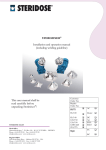
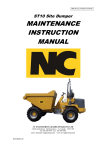

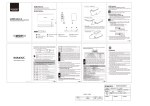


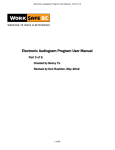
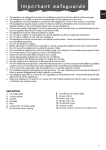

![Overture 2 Owner`s Manual [US]](http://vs1.manualzilla.com/store/data/005690862_1-0f7bb48baaf3473aa086657512069e12-150x150.png)
